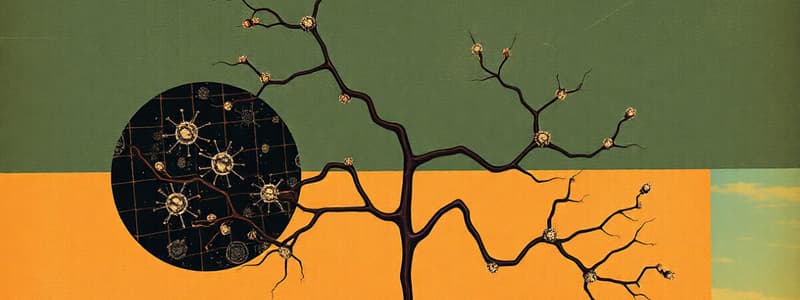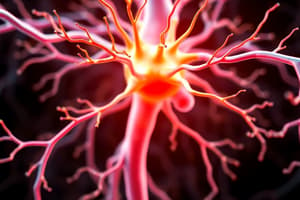Podcast
Questions and Answers
What is a severe form of infection that can lead to liver failure?
What is a severe form of infection that can lead to liver failure?
- Weil’s Disease (correct)
- Chronic Fatigue
- Respiratory Distress
- Meningitis
Which strain of poliovirus was declared eradicated in 2015?
Which strain of poliovirus was declared eradicated in 2015?
- Type 2 (correct)
- Type 3
- Type 4
- Type 1
What is a primary preventive measure against infections associated with contaminated water?
What is a primary preventive measure against infections associated with contaminated water?
- Taking antihistamines
- Staying hydrated
- Vaccinating children
- Wearing protective clothing (correct)
Which of the following is NOT a flu-like symptom of early infection?
Which of the following is NOT a flu-like symptom of early infection?
What symptom indicates the potential severity of poliomyelitis?
What symptom indicates the potential severity of poliomyelitis?
Which antibiotic is effective for treating infections if started early?
Which antibiotic is effective for treating infections if started early?
What type of virus is poliovirus classified as?
What type of virus is poliovirus classified as?
Chronic effects after treatment may include which of the following?
Chronic effects after treatment may include which of the following?
Which of the following are early symptoms of herpes encephalitis?
Which of the following are early symptoms of herpes encephalitis?
What is the primary treatment for herpes encephalitis?
What is the primary treatment for herpes encephalitis?
Which imaging technique is useful for diagnosing herpes encephalitis?
Which imaging technique is useful for diagnosing herpes encephalitis?
Which symptom is NOT associated with neurological progression of herpes encephalitis?
Which symptom is NOT associated with neurological progression of herpes encephalitis?
What is a common transmission method for West Nile virus?
What is a common transmission method for West Nile virus?
Which of the following symptoms is considered mild for West Nile virus encephalopathy?
Which of the following symptoms is considered mild for West Nile virus encephalopathy?
What is a potential complication of herpes encephalitis?
What is a potential complication of herpes encephalitis?
What preventive measure can reduce the risk of herpes simplex virus transmission?
What preventive measure can reduce the risk of herpes simplex virus transmission?
What is the primary purpose of the shingles vaccine?
What is the primary purpose of the shingles vaccine?
What triggers the reactivation of the varicella-zoster virus?
What triggers the reactivation of the varicella-zoster virus?
Which of the following is NOT a common over-the-counter pain reliever?
Which of the following is NOT a common over-the-counter pain reliever?
How is herpes encephalitis primarily caused?
How is herpes encephalitis primarily caused?
What condition may persist even after the shingles rash resolves?
What condition may persist even after the shingles rash resolves?
What is the characteristic feature of the rash caused by shingles?
What is the characteristic feature of the rash caused by shingles?
Which of the following practices can help prevent the transmission of the varicella-zoster virus?
Which of the following practices can help prevent the transmission of the varicella-zoster virus?
What is the main method of transmission for herpes simplex virus leading to herpes encephalitis?
What is the main method of transmission for herpes simplex virus leading to herpes encephalitis?
What is the primary function of serotonin in the body?
What is the primary function of serotonin in the body?
Which system is responsible for voluntary movements?
Which system is responsible for voluntary movements?
What is the role of the sympathetic nervous system?
What is the role of the sympathetic nervous system?
What component detects a stimulus in a reflex arc?
What component detects a stimulus in a reflex arc?
Where does information processing occur in a reflex arc?
Where does information processing occur in a reflex arc?
What is the status of normal flora in the nervous system?
What is the status of normal flora in the nervous system?
What is the primary inhibitory neurotransmitter that reduces neural activity?
What is the primary inhibitory neurotransmitter that reduces neural activity?
What protects the central nervous system from microorganisms?
What protects the central nervous system from microorganisms?
What is the primary causative agent of sleeping sickness?
What is the primary causative agent of sleeping sickness?
Which type of sleeping sickness is primarily found in East Africa?
Which type of sleeping sickness is primarily found in East Africa?
Which of the following is NOT a symptom of the early stage of sleeping sickness?
Which of the following is NOT a symptom of the early stage of sleeping sickness?
What is a rare route of transmission for sleeping sickness?
What is a rare route of transmission for sleeping sickness?
Which medication is used for treating the late stage of Trypanosoma brucei gambiense?
Which medication is used for treating the late stage of Trypanosoma brucei gambiense?
What is a significant complication if sleeping sickness is left untreated?
What is a significant complication if sleeping sickness is left untreated?
Which of the following is a preventive measure against sleeping sickness?
Which of the following is a preventive measure against sleeping sickness?
What is the main challenge in the prognosis of late-stage sleeping sickness?
What is the main challenge in the prognosis of late-stage sleeping sickness?
Flashcards are hidden until you start studying
Study Notes
Neurotransmitters
- Serotonin: Regulates mood, appetite, and sleep.
- GABA (Gamma-Aminobutyric Acid): An inhibitory neurotransmitter that reduces neural activity.
Peripheral Nervous System (PNS)
- Comprises nerves and ganglia outside the brain and spinal cord, linking the CNS to the body.
- Divided into two main systems:
- Somatic Nervous System (SNS): Controls voluntary movements, relaying signals between CNS and skeletal muscles.
- Autonomic Nervous System (ANS): Regulates involuntary functions like heart rate and digestion, further divided into:
- Sympathetic Nervous System: Activates "fight or flight" response, elevating heart rate and energy availability.
- Parasympathetic Nervous System: Promotes "rest and digest" response, aiding energy conservation and digestion.
- Enteric Nervous System: Controls gastrointestinal function.
Reflex Arc
- Simplest neural circuit enabling automatic reflex responses to stimuli.
- Processes reflex actions at the spinal cord, bypassing the brain for quicker reactions.
- Components include:
- Sensory Receptor: Detects stimulus.
- Sensory Neuron: Transmits impulse to spinal cord.
- Interneuron: Processes information in the spinal cord.
- Motor Neuron: Sends signal to effector to generate a response.
Microbial Environment in the Nervous System
- No normal flora is present in the nervous system; it remains sterile to prevent infections.
- Central nervous system protection includes the blood-brain barrier (BBB), controlling substance entry.
Symptoms of Neurological Infections
- Early Symptoms: Flu-like signs such as high fever, headache, chills, muscle aches, nausea, and diarrhea.
- Severe Symptoms:
- Weil’s Disease: Causes liver failure and kidney damage.
- Meningitis: Inflammation of protective membranes of the brain and spinal cord.
- Respiratory Distress: Breathing difficulties.
Diagnosis and Treatment for Infections
- Diagnosis often involves blood tests.
- Antibiotics like doxycycline or penicillin are effective when started early.
- Preventive measures include avoiding contaminated water, wearing protective clothing, and controlling rodents.
Poliomyelitis (Polio)
- Infectious viral disease affecting the nervous system, potentially causing paralysis.
- Causative agent: Poliovirus from Enterovirus genus, with three serotypes: Type 1 (most prevalent), Type 2 (eradicated in 2015), and Type 3 (reduced incidence due to vaccination).
- Symptoms:
- Asymptomatic cases are common.
- Pain relief via over-the-counter medications like ibuprofen.
Shingles
- Caused by the reactivation of varicella-zoster virus (VZV), dormant after chickenpox.
- Reactivated by factors such as stress or immunosuppression, leading to localized skin symptoms.
- Treatment and Prevention:
- Shingles vaccine recommended for adults aged 50 and older.
- Good hygiene practices help reduce transmission risk.
Herpes Encephalitis
- Inflammation of the brain mainly caused by herpes simplex virus type 1 (HSV-1).
- Symptoms:
- Early: Fever, headache, malaise.
- Severe: Confusion, seizures, coordination loss, personality changes.
- Diagnosis: Clinical evaluation, MRI scans for brain inflammation, and CSF analysis.
- Treatment: Intravenous acyclovir and supportive care improve outcomes.
West Nile Virus Encephalopathy
- Caused by West Nile virus (WNV), primarily transmitted via mosquito bites.
- Signs and Symptoms: Mild flu-like symptoms, with severe cases leading to neurological complications.
African Sleeping Sickness
- Caused by Trypanosoma species transmitted by tsetse flies.
- Symptoms:
- Early: Fever, headache, and joint pain.
- Late: Behavioral changes, sleep disturbances, and Neurological complications.
- Diagnosis: Clinical evaluation and laboratory tests to identify parasites.
- Treatment: Antiparasitic medications vary by disease stage.
Cerebral Malaria
- Severe form of malaria affecting the brain and central nervous system.
Studying That Suits You
Use AI to generate personalized quizzes and flashcards to suit your learning preferences.




